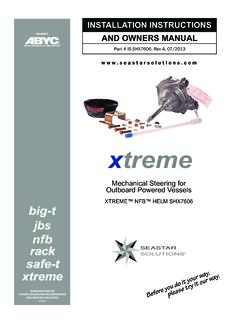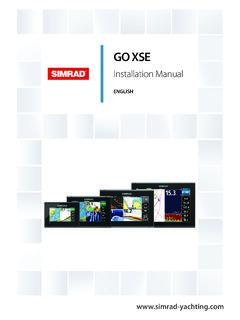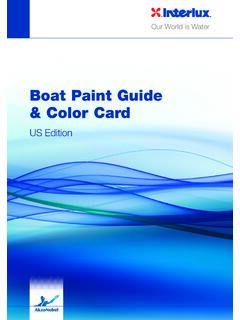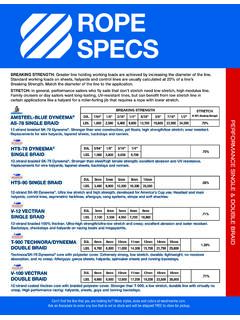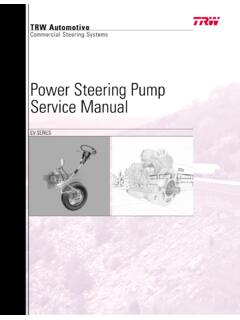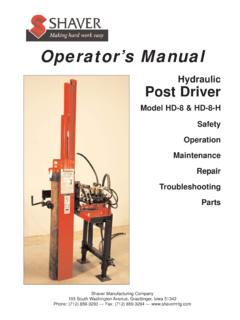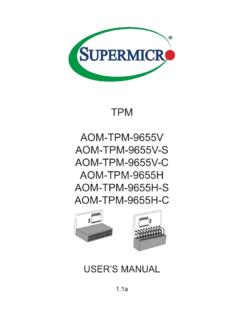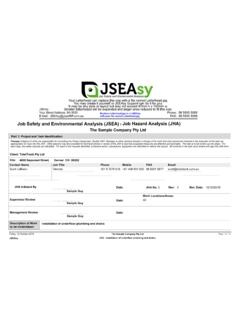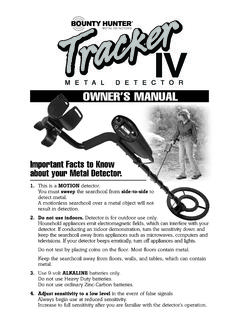Transcription of NOCO Genius GEN2 On-Board Battery Charger User Guide
1 GuideGuide de l utilisateurGu a de usuarioWELCOME!Thank you for buying a NOCO Genius GEN Series On-Board Battery Charger . SAVE THESE INSTRUCTIONS. This User Guide contains important safety and operating S IN THE BOX: GEN Series On-Board Battery Charger User Guide Hardware KitCONTACTING NOCO:Risk of SERIOUS INJURY OR SHOCK, EXPLOSION, FIRE, AND EYE INJURY YOURSELF AND OTHERS. 30339 Diamond Parkway, #102 Glenwillow, OH 44139 United States of AmericaPhone:Email:Mailing Address:DANGERB efore use, READ AND UNDERSTAND Quick Start Guide and Owner s Manual and User Guide . Failure to read and understand this information could result in SERIOUS INJURY or NOT REMOVE OR COVER THIS SHOCK HAZARDCHARGER IS AN ELECTRICAL DEVICE THAT CAN SHOCK AND CAUSE SERIOUS NOT CUT POWER CORDS. Battery POSTS, TERMINALS, AND RELATED ACCESSORIES CONTAIN CHEMICALS, INCLUDING LEAD, KNOWN TO THE STATE OF CALIFORNIA TO CAUSE CANCER AND BIRTH DEFECTS OR OTHER REPRODUCTIVE HARM.
2 ALWAYS WASH YOUR HANDS AFTER HANDLING THESE HAZARDCHARGER IS AN ELECTRICAL DEVICE THAT EMITS HEAT AND CAN NOT COVER Charger . EXPLOSION HAZARDUNMONITORED, INCOMPATIBLE, OR DAMAGED BATTERIES CAN EXPLODE IF USED WITH NOT LEAVE Charger UNATTENDED WHILE IN USE. DO NOT ATTEMPT TO CHARGE DAMAGED OR FROZEN Charger ONLY WITH BATTERIES OF RECOMMENDED Charger ONLY IN WELL-VENTILATED NOT SMOKE OR USE ANY OTHER SOURCE OF ELECTRICAL SPARK OR FIRE WHEN OPERATING Charger AWAY FROM COMBUSTIBLE INJURY HAZARDBATTERIES CAN EXPLODE AND CAUSE FLYING ACID CAN CAUSE EYE EYE PROTECTION WHEN OPERATING CONTACT WITH EYES AND WASH HANDS AFTER USING CASE OF EYE CONTACT, FLUSH AFFECTED AREA WITH PLENTY OF WATER. WARNINGWARNINGRISK OF EXPLOSIVE GASES WORKING IN VICINITY OF A LEAD-ACID Battery IS DANGEROUS. BATTERIES GENERATE EXPLOSIVE GASES DURING NORMAL Battery OPERATION.
3 FOR THIS REASON, IT IS OF UTMOST IMPORTANCE THAT YOU FOLLOW THE INSTRUCTIONS EACH TIME YOU USE THE reduce risk of Battery explosion, follow these instructions and those published by Battery manufacturer and manufacturer of any equipment intended to be used in vicinity of Battery . Review cautionary markings on these products and on of an attachment not recommended or sold by the Battery Charger manufacturer may result in a risk of fire, electric shock, or injury to reduce risk of damage to electric plug and cord, pull by plug rather than cord when disconnecting not operate Charger with damaged cord or plug replace the cord or plug not operate Charger if it has received a sharp blow, been dropped, or otherwise damaged in any way; take it to a qualified service NOT USE EXTENSION CORDS unless absolutely necessary.
4 Using an improper extension cord could result in a risk of fire and electric shock and may result in property damage, personal injury or death. If extension cord must be used, make sure that:1.) The pins on the extension cord plug have the same number, size, and shape as those of the AC power cord plug on the Charger . 2.) The extension cord is properly wired and is in good electrical condition. 3.) The wire size is as specified in Table 1 below:RECOMMENDED MINIMUM AWG SIZE FOR EXTENSION CORDS FOR Battery CHARGERSTABLE 1:AC INPUT RATING, AMPERES*Equal To Or Greater ThanBut Less Than25( )023456810121416181818181818181816161614 1418161614141212101010882345681012141618 2018181818161614141212121216141412121010 88886100( )50( )150( )AWG SIZE OF CORDL ength Of Cord, Feet (f)*If the input rating of a Charger is given in watts rather than amperes, the corresponding ampere rating is to be determined by dividing the wattage rating by the voltage rating - for example:1250 watts/125 volts = 10 amperesDo not disassemble Charger ; take it to a qualified service facility when service or repair is required.
5 Incorrect reassembly may result in a risk of electric shock or reduce risk of electric shock, unplug Charger from outlet before attempting any maintenance or cleaning. Turning off controls will not reduce this CONNECTIONS TO Charger SHALL COMPLY WITH THE UNITED STATED COAST GUARD ELECTRICAL REGULATIONS (33 CFR183, SUB PART I)USE THE FOLLOWING PRECAUTIONS WHEN YOU WORK NEAR LEAD-ACID BATTERIES: Someone should be within range of your voice or close enough to come to your aid if you have an accident. Have plenty of fresh water and soap nearby in case Battery acid contacts skin, clothing, or eyes. Wear complete eye protection and protective clothing. Avoid touching your eyes while working near a Battery . If Battery acid contacts your skin or clothing, wash immediately with soap and water. If acid enters an eye, immediately flood the eye with running cold water for at least ten (10) minutes and seek medical attention as soon as possible.
6 Be extra cautious when handling metal tools around a Battery . If you drop a metal tool near a Battery it might spark or create a short circuit between the Battery terminals and some other metal part. Either event may cause a dangerous electrical shock hazard, a fire, or even an explosion, resulting in property damage, personal injury, or death. Never smoke or allow an open spark or flame in the vicinity of the Battery or engine. Remove all personal items made of metal, such as, rings, bracelets, necklaces, and watches when working with a lead-acid Battery . A lead-acid Battery can produce a short-circuited current high enough to weld a metal ring or other piece of jewelry, causing a severe burn. This Battery Charger is for charging LEAD-ACID BATTERIES ONLY. DO NOT USE THE Battery Charger FOR DRY-CELL BATTERIES THAT ARE COMMONLY USED WITH HOME APPLIANCES.
7 THESE TYPES OF BATTERIES MAY BURST AND MAY CAUSE property DAMAGE, PERSONAL INJURY OR DEATH. NEVER charge a frozen CHARGING To avoid an electric arc (or spark), turn off or disconnect all of the accessories in the boat or vehicle. Always remove the cable that is connected to grounded terminal from Battery first. Make sure the area around the Battery is well-ventilated while the Battery is being charged. If necessary, use a non-metallic material to fan away the gas in the area. If necessary, clean the Battery terminals. Be careful to keep the corrosion and other debris from coming in contact with your skin or eyes. If the Battery is not a sealed Battery , add distilled water to each cell (if necessary) until the Battery acid solution reaches the level specified by Battery manufacturer. Do not overfill. For a Battery without cell caps, such as a valve regulated lead-acid Battery (VRLA), carefully follow the Battery manufacturer s charging instructions.
8 Before charging, carefully read the Battery manufacturer s specific precautions and recommended rates of charge. Determine the voltage of the Battery by referring to the boat s or vehicle s owner s manual and make sure that the Battery Charger has 6compatible voltages. If using an extension cord, always connect to the Battery Charger first, before connecting to an electrical outlet. When disconnecting, always disconnect from the electrical outlet first. Make sure the electrical outlet is a 120 VAC GFCI (Ground Fault Circuit Interrupt) Battery Charger Locate the Battery Charger as far away from the Battery as possible. Never place the Battery Charger directly above the Battery ; gases from Battery will corrode and damage Battery Charger . When reading electrolyte specific gravity or filing Battery , never allow Battery acid to come in contact with the Battery Charger .
9 Do not operate the Battery Charger in a closed-in area or an area with restricted ventilation. Do not set a Battery on top of Battery SPECSThe following recommendations should ONLY be considered as guidelines. Always refer to the Battery manufacturer s recommendations for Battery charging. The GEN Series On-Board Battery Chargers are suitable for charging all types of 12V lead-acid batteries, including Wet (Flooded), Gel, MF (Maintenance-Free) and AGM (Absorption Glass Mat) batteries. The GEN Series On-Board Battery Chargers can be used on Battery sizes from 25 to 230Ah, but can also maintain all Battery TO THE BATTERYB efore you connect to the Battery (s), make sure that the AC power plug is not connected to an electrical outlet. DO NOT CONNECT THE Battery Charger AC POWER PLUG TO THE ELECTRICAL OUTLET UNTIL ALL OTHER CONNECTIONS ARE MADE.
10 Make sure you have identified the correct polarity of the Battery terminals on the Battery (s). The POSITIVE Battery terminal is typically marked by these letters or symbols (POS,P,+). The NEGATIVE Battery terminal is typically marked by these letters or symbols (NEG,N,-). If you are having difficulty determining the polarity of the Battery terminals, contact the Battery manufacturer before ) Confirm that you have a 12V Battery (s). This Battery Charger is for 12V LEAD-ACID BATTERIES ONLY. 2.) Connect the POSITIVE (Red) eyelet terminal connector to the POSITIVE (POS,P,+) Battery terminal. 3.) Connect the NEGATIVE (Black) eyelet terminal connector to the NEGATIVE (NEG,N,-) Battery ) Repeat steps 2 and 3 for each Battery ) When disconnecting the Battery Charger , disconnect in the reverse sequence, removing the NEGATIVE first.

